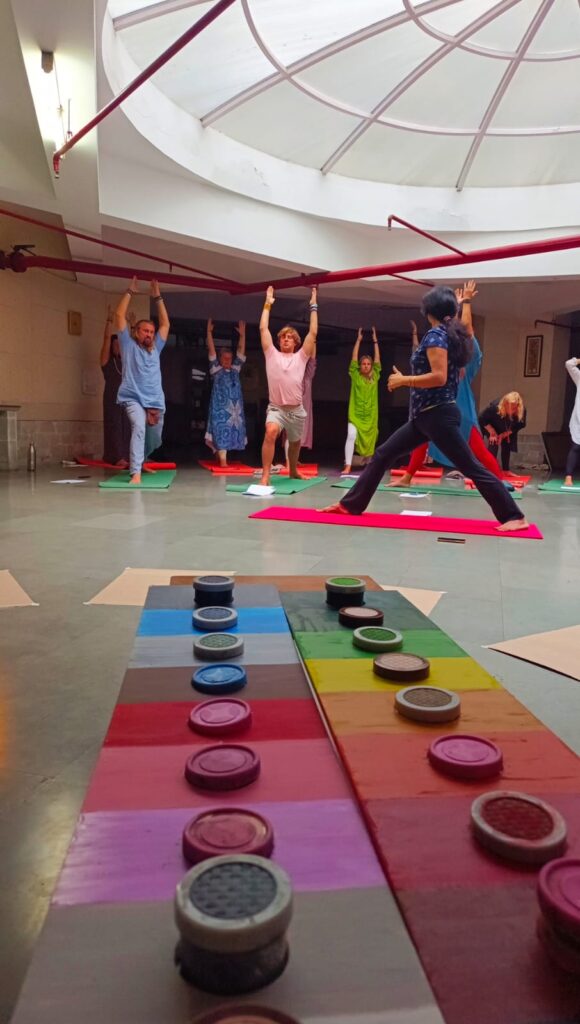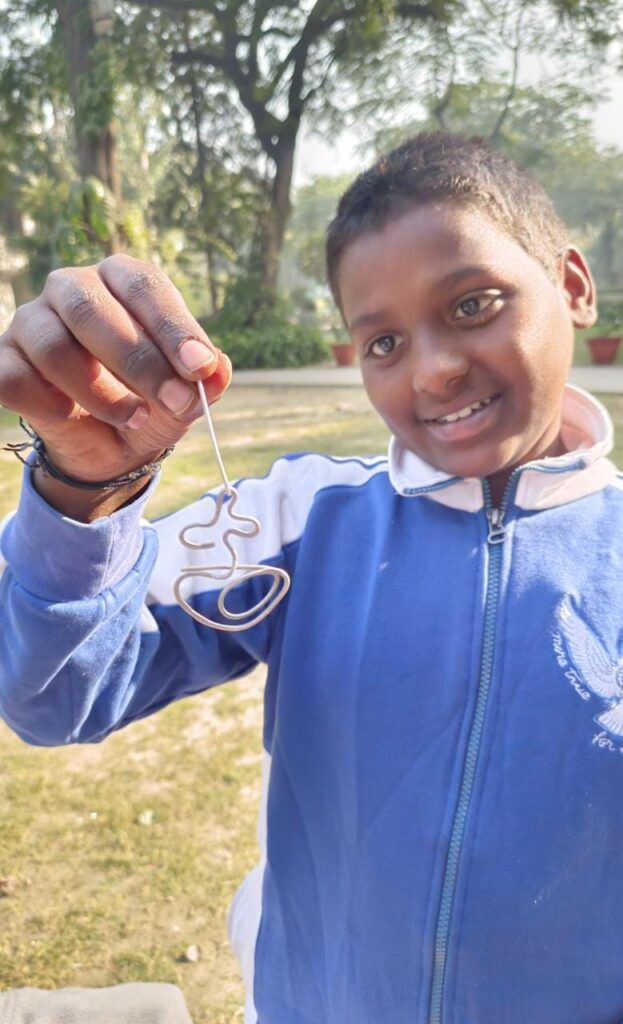Volume V, Issue 10-11
Authors: Monica Chand and Egle J. Raie Dey
Editor’s Note: The authors of this article are co-founders of YogArt, an organization based in National Capital Region. YogArt is dedicated to giving practical form to the Mother’s teaching that essentially “the discipline of Art has at its center the same principle as the discipline of Yoga”. Monica Chand is a certified Hathayoga teacher with deep interest in exploring art as a yogic discipline. Egle J. Raie Dey has more than 30 years of experience in the fields of Art & Design as an artist and art educator.
In this article they share a brief account of the work they do through YogArt. Read more about the authors at the end of the article.

“The discipline of Art has at its centre the same principle as the discipline of Yoga. In both the aim is to become more and more conscious; in both you have to learn to see and feel something that is beyond the ordinary vision and feeling, to go within and bring out from there deeper things.
“Painters have to follow a discipline for the growth of the consciousness of their eyes, which in itself is almost a Yoga. If they are true artists and try to see beyond and use their art for the expression of the inner world, they grow in consciousness by this concentration, which is not other than the consciousness given by Yoga. Why then should not Yogic consciousness be a help to artistic creation?”
~ The Mother, CWM, Vol. 3, p. 105
Our Inspiration
Art as Yoga and Yoga as Art — this is the inspiration behind YogArt.
We started YogArt with a very specific intention. It was to give a practical form to a holistic and spiritual education using practices of Yoga and Art. We were also interested in observing and assessing the tangible and intangible outcomes of such an educational approach.
At a first glance, it may seem that Yoga and Art are very diverse. And it may not be possible to merge the two. But on a closer look we see differently. Particularly, as we reflect on the Mother’s quote cited at the beginning, we find great many converging and complementary points in both these disciplines.



The inner and outer practices of Yoga bring one to a state of inner calm and balance. And that is the perfect base for any activity in life. This is especially important when one wants to be able to create something or bring down something from a higher plane, not accessible to the ordinary or waking mind. These practices seem complex to a layman. But when presented in a simple manner, they can be made easy to follow and the results are outstanding.
As for Art, we find that unless someone is an artist or comes from a family of artists, the experience and practice of it in daily life is very flawed and insufficient. Also, unless someone intends to take up art in higher education, it is considered an unnecessary diversion.
Read:
The Mother on Art and Yoga
In our mainstream education system, both Yoga and Art are given a subordinate position, as opposed to disciplines such as STEM (Science, Technology, Engineering and Mathematics) and Languages. Examinations take precedence over everything else. Physical education and Art are both given insignificant amount of time and importance. And even the odd art period is often dispensable to compensate for classes in any other subject.
The result of all this is a lack of development of an artistic temperament and a lack of aesthetic development in general, thus giving more importance to the development of only one side of the brain.



As we humans evolve, we need to acquire and gain mastery over a great number of skills to navigate life. The life skills that we need in this day and age are much more complex and wide as compared to what we might have needed even a decade ago. Additionally, the pressure for spiritual unfolding growth that human beings are experiencing today is far greater. A key reason for that is the supramental descent which Sri Aurobindo and the Mother brought into the earth consciousness in 1956.
In other words, an average human being today must develop abilities and skills which were perhaps not so much needed earlier. Physical fitness, mental calmness and peace, emotional balance and stability along with a creative problem solving mindset, aesthetic development and a sense of connectedness with all of creation — all these things have now become a common requirement, especially if one wants to have a purposeful life.
READ
Embracing Life in Its Many Colours and Hues
We were mindful of these needs; and we carefully worked to develop a meaningful practice which could address them through Yoga and Art. Incorporating diverse yogic techniques such as movement, breath control, sound, mindfulness, observation, colours, hand eye coordination, hand skills, and intentional use of a variety of materials, we have been able to work on all the above-mentioned skills through one seamless practice.



Practice that Works on All Parts of Our Being
The reason we call this practice holistic is because it works on all the parts of our being — body, emotions, mind, soul. Carefully crafted movement practices along with breathing exercises, use of sound and meditation and mindfulness techniques focus on calming the body, mind, emotions. This results in balancing and widening them to access the invisible element in us. At the same time, use of art techniques and materials, and cultivating skills with a view to develop creativity, aesthetic sense, colour balance etc. tap into our inherent creativity. This helps bring about a change in our instruments.
Over the years we have discovered that this practice also serves a great therapeutic purpose. This has been an important finding of our work. Stress is the cause of a wide range of health problems, physical, mental or emotional. Stress affects us as a whole. Our carefully crafted practices are able to address the problem of stress in people of all ages. And they do that in a fun and engaging manner. For the restless, it gives the opportunity to bring in calm. For the anxious, it gives tools to bring down peace. And for the sedentary person, it gives an opportunity to engage in fun movements etc.
Sri Aurobindo says that unless education addresses the Soul, it is not Spiritual. This is where YogArt helps to celebrate the uniqueness of each individual by identifying each one’s primary soul drive while also working on building the other three.
Between them music, art and poetry are a perfect education for the soul; they make and keep its movements purified, self-controlled, deep and harmonious.
~ Sri Aurobindo, CWSA, Vol. 1, p. 448




Working with Different Age Groups
We have worked with 3 distinct groups — children, young adults and adults. And our experience has been different with each of these groups.
With children, we find it is very important to infuse the fun element into all the practices with movement, breath, sound and mindfulness while exploring the art techniques in a simplified manner. Our aim with them is to build focus and introduce them to a variety of materials as well as techniques so that new networks are formed in their brains. We introduce them to the concept of warm and cool colours, scribble art, metal art etc. All this will help them cultivate and refine a number of soft skills in the future.
When working with young adults we find that it is important to make the practice interesting as well as engaging since their minds need a bit of challenge. Also, their bodies can be pushed more. However, over time we have also seen that we need them to internalise a lot more than younger children, because it helps build better focus as well as develop patience and skill. The learning outcomes we focus mostly are: enhancement of creativity, greater strength and stability in the body, skill enhancement, introduction to more complex materials such as lippan art, flower printing, metal art, glass work etc.
“Literature and art are or can be first introductions to the inner being—the inner mind and vital; for it is from there that they come.”
~ Sri Aurobindo, CWSA, Vol. 27, p. 716
With adults, our practice has been more directed towards preservation. Our goal is to bring in more agility, lightness in the body, greater concentration, focus and creativity. While at the same time we focus on developing advanced skills such as mindful use of colours not only in creating artwork but also using them in bringing about a change in everyday life. For instance, we discuss how yellow and orange are colours of hunger and excessive use of them can stimulate hunger. Through the years we have learned that many times adults need to go through unlearning rather than learning. Through the practice we offer, they go through some unlearning process as well!





The use of Art in everyday life has been reduced because of the utilitarian view of modern life. Art is an excellent medium for development of the higher faculties of the human being which are neglected today. Through our work at YogArt we aim to change that. We try to do that by simplifying art and making it accessible to all through Yoga. And also by making Art itself a Yogic practice.
We also aim to popularise some of the indigenous arts of India which we have learned over the years. These include Madhubani painting, Gond art, Lippan art, and a few more. Working with such art forms also gives exposure to the rich and diverse culture of India. We also encourage working with a wide variety of materials such as clay, metal, flowers, wood etc. This not only widens the exposure to art appreciation and artistic creative processes, but also facilitates a more comprehensive learning and growth.
Art is nothing less in its fundamental truth than the aspect of beauty of the Divine manifestation.
The Mother, CWM, Vol. 3, p. 110
~ All photos by YogArt
About the Authors:
Lithuanian by birth, Egle J. Raie Dey has been living in India since 2004. She has been exposed to art since the age of 10, and has more than 30 years of experience creating a variety of art forms including traditional Indian arts. She has received her degree from London Metropolitan University and has been teaching art to children, besides running an interior design academy for the past 11 years in India. Inspired by the teachings of the Mother and Sri Aurobindo she has attended several workshops and courses at the Sri Aurobindo Ashram, Delhi branch.
Monica Chand is certified in Hathayoga and therapy from Krishnamacharya Yoga Mandiram (KYM). She has also attended several workshops and courses in Integral Yoga from Sri Aurobindo Ashram, Delhi branch. She has taught Hathayoga both nationally and international for more than 2 decades. For the last few years she has also been exploring Art as a yogic discipline, with a special emphasis on indigenous art forms of India.

WATCH:
Art and Yoga: An Online Experiential Session by the Authors
~ Design: Beloo Mehra



